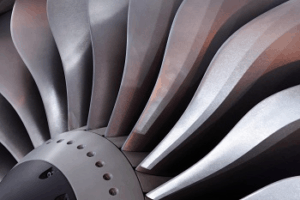How NDT Supports Gas Turbine Engine Maintenance and Inspection

Gas turbine engines can harbor many undetected flaws that could hamper machine functionality. Years ago, liquid penetrant testing (LPT) was one of the most common testing methods, but more modern nondestructive testing (NDT) techniques have emerged as being more effective. Gas turbine engine maintenance and inspection plans call for precise NDT campaigns that can perform actions such as measuring the size of gas turbine cracking.
The two most important NDT solutions for gas turbine inspections are phased array ultrasonic testing (PAUT) and eddy current array (ECA). ECA and PAUT provide the necessary reliability that can access hard-to-reach regions. This article will explain why ECA and PAUT are two preferred methods for the inspection of gas turbines and vanes.
How Can ECA Enhance Gas Turbine Engine Maintenance and Inspection?
With ECA, the probes can conform to complex geometric patterns of gas turbines and vanes. Users can also apply multi-coil sets for any part of the turbine inspection process, ensuring a testing regimen that’s devoid of misalignments or haphazard adjustment schemes. Additionally, the rows of coils allow analysts to extract more data in a single pass, hastening inspection times while receiving quality data. Moreover, array capabilities provide detachable encoders that can inspect multiple positions of a gas turbine, streamlining the testing process and ensuring that all areas of the testing radius are covered adequately.
To maximize inspection parameters for gas turbines, look for the following attributes in eddy current testing (ECT) instrumentation:
- Handheld portability and ergonomics that allow technicians to comfortably inspect more areas for increased inspection productivity
- Advanced features that help technicians find more flaws in less time
- Dual frequency mixing that dispels unnecessary signals
- Compatibility with a wide range of probes and scanners, including flexible probes that enable technicians to inspect challenging or hard-to-reach areas
- Intuitive user interface, which leads to an inherently higher probability of detection and reduces the amount and frequency of training required
- A rugged, durable design and enough battery life to last an entire shift without recharging
The dual-frequency function is especially noteworthy due to its ability to compensate for air gaps between the layering that can cause unneeded signals to flourish, fostering a signal-to-noise ratio that can further probe multi-layer structures found within blades. Complex layering can be challenging to inspect, but a good ECT instrument can adjust to skin thickness variations or multiple layers while producing a sharpened signal quality.
When paired with array features, ECT equipment can expedite the inspection process by as much as 95 percent compared to standard pencil probing. Analysts can also achieve the same efficient inspection perks if they need to inspect gas turbine engines volumetrically.
How Can PAUT Enhance Subsurface Testing Campaigns?
To probe subsurface areas, PAUT relies on wave beam customizations, enhanced focus depths, and multiple probing angles. The improved speed and resolution fosters a more complete picture of internal layouts. PAUT differs from conventional UT because ordinary UT provides fixed beaming positions, which often fail to detect varied forms of disruptions that can degrade machine functionality.
On the other hand, PAUT allows users to apply various angles without incessant probe changes or frequent adjustments. Therefore, users can find flaws that would have remained hidden otherwise. Further, the linear scanner usability supplants raster motion, which secures a more well-rounded coverage feature.
The instrumentation behind PAUT is just as important as the probe. Look for the following qualities in your instrumentation:
- Advanced techniques such as Time-of-Flight Diffraction (TOFD)
- Fully integrated and portable
- Powerful software features and capabilities
The software dexterity is imperative because it provides easier online and offline data analysis than other NDT methods. UT software also provides high-resolution mapping, which can be further enhanced by using instruments that can support the total focusing method algorithm. More importantly, UT equipment has enough power to pervade thick welding and/or composite sections of gas turbines and vanes, allowing the probes to reach further into the subsurface layers and obtain accurate data.
Gas Turbine Engine Maintenance and Inspections Plans
The array capabilities of ECT and UT offer a detailed inspection plan that can find many types of flaws in the form of corrosion, cracking, and pitting. PAUT and ECA provide an in-depth view of spotted defects, with the addition of customizations and tailored mechanisms that can conform to unconventional contours of gas turbine engines and vanes. The array options provide greater flexibility and tailored choices that allow inspectors to finish the testing sessions faster.
Gas turbine engine maintenance and inspection plans have relied on LPT in the past, but since LPT provides substandard data and cumbersome setup procedures, PAUT and ECA outperform LPT in almost every way. The array option also enhances UT and ECT in many regards, including the measurements of cracking or the detection of corrosion within multi-layered structures. Therefore, technicians can spot indications early and alert maintenance crews of necessary repair mandates, securing gas turbine integrity and preserving the efficiency of aircraft.
Zetec is a major provider of ECA and PAUT equipment for gas turbine and vane inspections. Contact us today to get a custom inspection plan for your aircraft inspection endeavors, in addition to learning how our equipment can help you find deficiencies within engine components.

Zetec’s designers are industry-leading experts in ultrasonic and eddy current technologies, and we can help you navigate any of our NDT testing solutions or devices.
